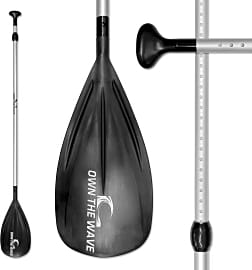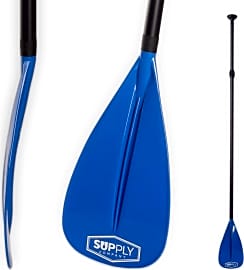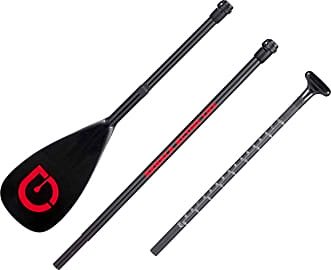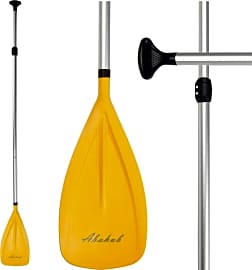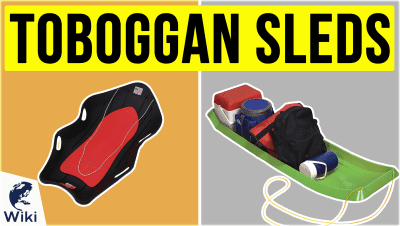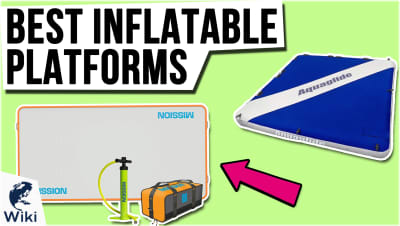The 10 Best SUP Paddles

This wiki has been updated 37 times since it was first published in April of 2016. If one of your favorite pastimes is stand-up paddleboarding, you will want to take a look at our selection of SUP paddles, one of which will be perfect for propelling you across the lake or ocean of your choice. They come in models designed for convenient portability, durability or both, so you can select the right one for your needs and budget. Most will float if dropped in the water, too. When users buy our independently chosen editorial recommendations, we may earn commissions to help fund the Wiki.
Editor's Notes
June 30, 2020:
The right tools for the job isn't just a saying that applies to contractors and mechanics. It is just as valid of a statement in sports and a variety of other situations, too. With that in mind, we made sure to include a variety of paddle types on this list so everyone from beginners to experienced SUP riders, and tourers to racers could find something that perfectly fits their needs.
Those who spend a lot of time on the water should look to a premium paddle made from carbon fiber, such as the BPS Adjustable 2-Piece Carbon Fiber, Super Paddles Elite 12K Bamboo, Werner Trance 95, and Akuala 3-Piece Adjustable Carbon. These will generally be the lightest, especially in the case of the Werner Trance 95, which weighs a mere 1.2 pounds, and are also the stiffest. Stiffness is important for anyone who wants to go fast or conserve their energy for long paddling sessions, since this directly affects the efficiency of power transfer from your muscles to the blade. Of all these, we feel the Super Paddles Elite 12K Bamboo offers the best balance of style and performance, but it didn't snag the top spot because, at 1.8 pounds, it is slightly heavy for a carbon fiber model.
Unfortunately, carbon fiber models can be pricey, so SUP riders who are trying to save a bit of cash may want to opt for a fiberglass model, such as the Kerco Travel 316350. The Bic Sport Original is also available in a fiberglass option. Fiberglass paddles will be slightly heavier than carbon, but still lighter than aluminum options and with better performance. There can be great deals on some fiberglass paddles too, as evidenced by the Kerco Travel 316350, which doesn't cost any more than most aluminum models. Of these two, we recommend the Kerco over the Bic Sport Original if you care more about performance than style, since its blade is made from a fiberglass-reinforced nylon, which means it should have less flutter than the plastic blade on the Bic Sport.
Beginners and rental companies will probably want to opt for a basic aluminum model with a plastic or nylon head, like the Own the Wave Alloy, SUP Supply Explorer, Super Paddles Alloy Junior, and Abahub 3-Piece Alloy. These are all affordable and can get the job done well enough that most newbs won't even notice the efficiency loss in their stroke. Also, except for the SUP Supply Explorer, they can all stand up to a beating for the most part, so you won't have to worry too much if you accidentally whack a rock or your board a few too many times.
Special Honors
Bending Branches Balance The Bending Branches Balance definitely wins style points with its handcrafted basswood and red alder blade, which has a slightly squared profile and small size of just 85 square inches. It features an all-carbon shaft and is available in a one- or two-piece design. bendingbranches.com
Kialoa Insanity Though a bit pricey for a fiberglass model, the Kialoa Insanity is worth every penny. At just a tad over 1.5 pounds, it isn't any heavier than many carbon fiber options, thanks to the Fibrlite blade, which has a special profile designed for a solid catch. We also think many riders will appreciate the rubber-coated handle. kialoa.com
A Brief History Of Stand-Up Paddleboarding
Today, SUP continues to grow in popularity, with many enthusiasts enjoying it as much — if not more — than traditional surfing.
For virtually as long as there have been canoes, kayaks, or other watercraft, people have been using them for stand-up paddleboarding. It's a practice that developed independently in many different regions of the world, including Africa, Hawaii, and South America.
In Africa, warriors used it to sneak up on their enemies, riding dugout canoes and propelling themselves with their spears. The technique was virtually silent, making it the perfect delivery system for a sneak attack.
Meanwhile, in Peru, fishermen would stand on something called "caballitos de totora," or "little reed horses." These were very unstable crafts made of reeds that were either stood upon or straddled like a horse.
The Hawaiians, meanwhile, were becoming the original masters of surfing. The Hawaiians used either canoes or special boards made from the Koa tree, and these craft were so large that using a paddle to power yourself through the waves was a necessity.
When surfing surged in popularity in the 20th century, SUP did as well. In fact, part of the reason was due to the fact that surfing instructors needed a higher vantage point in order to keep a watchful eye on their students.
In the 1940s, a man named John Zapotocky was on vacation in Hawaii when he caught sight of the instructors. He immediately fell in love with SUP, and surfing in general. He quickly became such a regular on the water that the locals made him an honorary "Beach Boy," the name given to local surfing legends (he didn't get any royalties from the other Beach Boys, though). Today, he's considered by many to be the modern father of SUP.
By the 1990s, surfing was a global phenomenon. Instructors began teaching SUP as an alternative way to get out on the waves when there wasn't enough swell to surf, and the technique proved popular enough that many surfing competitions began offering SUP contests and races.
Today, SUP continues to grow in popularity, with many enthusiasts enjoying it as much — if not more — than traditional surfing. If you're just getting into paddling, SUP is an excellent way to get your feet wet, so to speak.
Actually, it's a pretty good way to get your entire body wet, as keeping yourself upright isn't nearly as easy as the pros make it look.
Choosing The Right Paddle
When looking for a high-quality SUP paddle, there are a few general things you should consider: length, blade size and shape, and material.
Getting the wrong length of paddle is obviously a mistake, as it will be hard to propel yourself if it's too long, and a paddle that's too short will leave you looking like you should be ringing the bells at Notre Dame. To find the right length, stand the paddle up next to you vertically with the blade on the ground, then reach your arm up toward the other end. The handle should reach the bend of your wrist. Keep shopping until you find one that fits, or get an adjustable model that you can tailor to your body.
When looking for a high-quality SUP paddle, there are a few general things you should consider: length, blade size and shape, and material.
A quick note on adjustable paddles: while many people like them for their versatility and the fact that multiple members of the family can use the same one, others like the increased rigidity that a fixed-length paddle offers. This is totally up to you, but you should try out both to see which you prefer.
The blade is the next thing to consider. There are two basic shapes: teardrop and rectangular. Teardrop blades are great for generating lots of speed and power, but they require quite a bit of effort, so they might not be suitable for beginners. Rectangular, on the other hand, give you a gentler stroke, but they're not ideal for racing.
The size of the blade will also play a big part in determining how much you enjoy your day on the water. Basically, the bigger the blade, the more water you can move — but the harder it'll be to push. Larger people can generally get away with larger blades, but this will ultimately come down to personal preference.
Finally, take a look at different paddle materials before you make your decision. Most beginner paddles will use plastic blades and aluminum shafts, which makes them less expensive and keeps you from dropping too much cash before you're sure the sport is for you. Once you get more experienced, you'll likely want to transition to a lighter, more rigid fiberglass model, and if you're still fanatical about your new hobby, carbon fiber paddles are top-of-the-line.
Once you find the perfect paddle, you'll be set for a day — or a lifetime — out on your board riding the waves.
Health Benefits Of Stand-Up Paddleboarding
SUP isn't just a fun and relaxing way to spend a weekend — it also gives you a killer workout.
One of the main benefits is that it engages your whole body, as everything from your shoulders to your hips gets involved with every stroke. You also get the double-whammy of a cardio workout with some resistance training thrown in, helping you to build muscle while shedding fat.
SUP isn't just a fun and relaxing way to spend a weekend — it also gives you a killer workout.
If you spend most of your workweek slumped over behind a desk, then SUP can help correct your posture. Because you'll need to balance yourself at all times, your core and lower back muscles will be constantly engaged, and keeping them in shape will do wonders for your alignment.
Of course, your body won't be the only thing that benefits from regular time on the water. It's extremely relaxing, and communing with nature will help reduce the stress of daily life. The regular rhythm of your stroke can have a calming effect similar to that offered by meditation, as well.
Getting into an SUP habit will do wonders for your health, both mentally and physically, and it's a lot of fun to boot — right up until you hear the theme music from Jaws.




